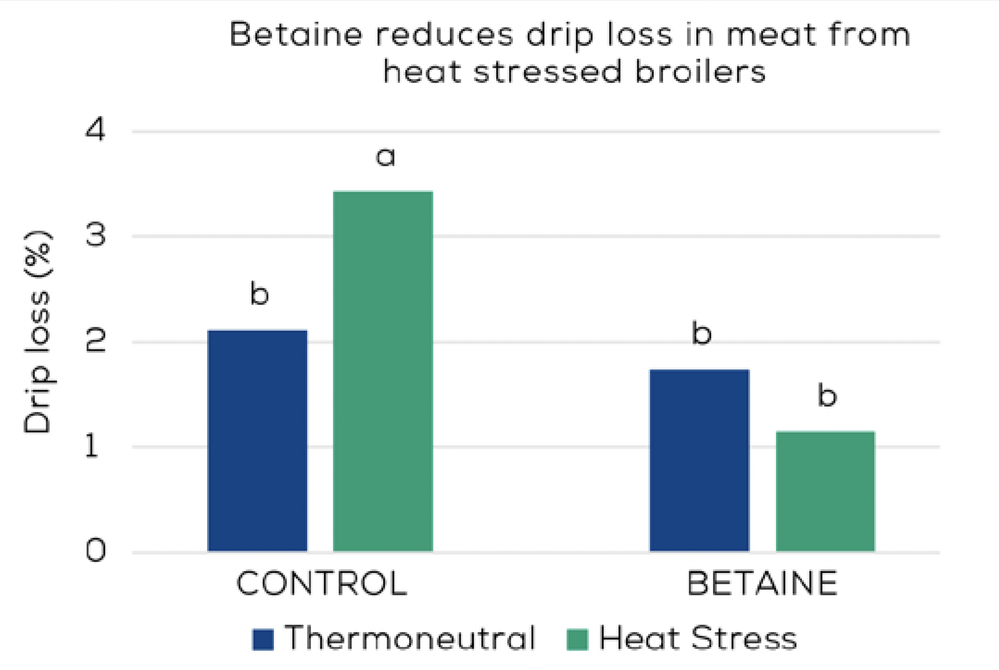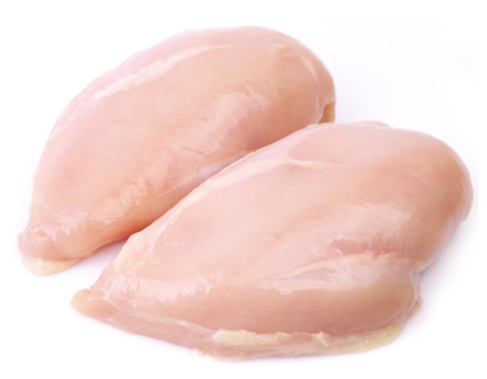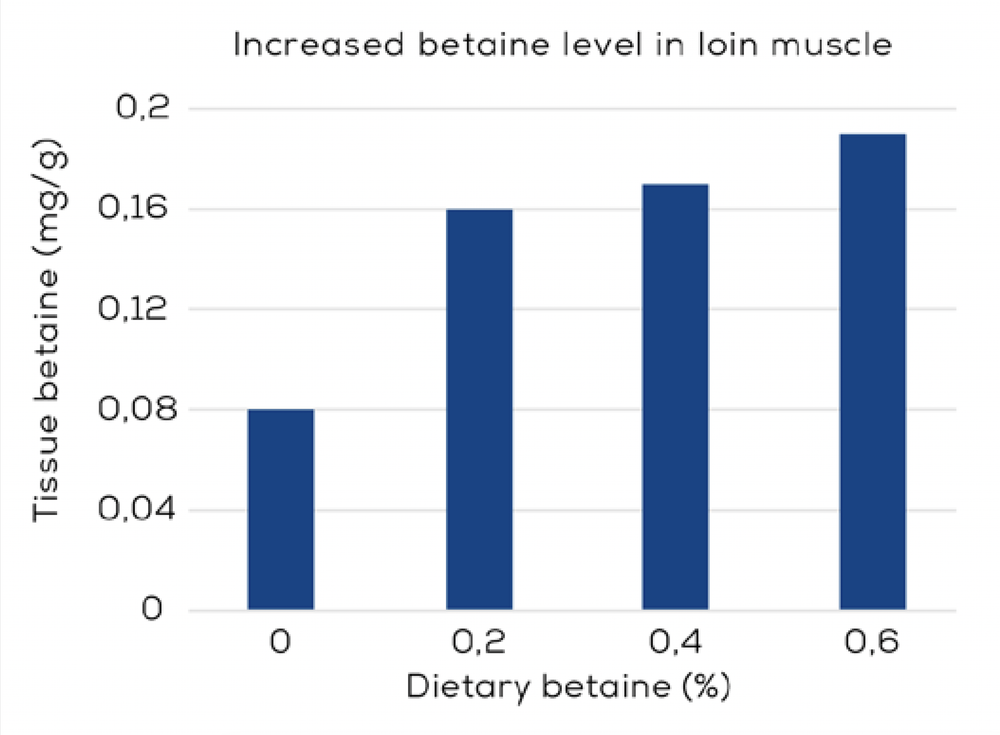Betaine as nutritional strategy to improve meat quality
Feed & Additive magazine, December 2022
Consumer satisfaction is an important requirement for the commercialization of meat products. With the increase of human welfare and living standards, people prefer better tasting meat with a nutritionally healthy composition. As a result, attention increases to improve the carcass traits and the meat quality in poultry, pork, beef and other meat production.
Influence of nutrition
Nutritional strategies have not only an impact on carcass composition such as fat and lean meat contents. Also, the sensory quality and the nutritional composition of the meat can be influenced by the feed. A specific example of such a nutritional strategy is the increase of dietary betaine levels by supplementing feed with betaine additives.
Dietary betaine supplementation is possible with either anhydrous betaine sources (available from natural or synthetic origin) or betaine hydrochloride. All these betaine additives are efficacious in providing available betaine for absorption. The availability of dietary betaine will subsequently influence multiple physiological processes.
Betaine is a naturally occurring compound in animals, with a vitamin-like nutritional function. In the liver, it is mainly involved in methyl group transition. In other cells it functions as an osmoprotectant: a protective regulator of the cellular osmotic pressure and water balance. The molecular structure of betaine is a derivative of the amino acid glycine, and consequently, betaine also has a role in protein metabolism. Moreover, the biological function of betaine has
an impact on lipid and energy metabolism.
It was already observed decades ago that betaine additives can alter fat distribution in the body of animals and thus influence carcass composition. Therefore, betaine is often referred to as a ‘carcass modifier’. Recently, more and more studies in different animal species show that meat quality is influenced as well and suggest betaine can also be considered as a ‘meat quality modifier’.
Betaine and meat quality
Meat quality is generally measured by two factors: the nutrients indexes and the sensory quality. Protein is the first and most important nutritious component of meat. The composition and content of proteinogen ic amino acids shape the nutritional value and flavor of the meat. Secondly, levels of fat and concentrations
of different fatty acids are also of importance for both the nutritional and sensory value of animal products.
Studies on the effect of betaine on nutrients indexes are limited, however the influence of betaine can be recognized due to its role in both protein and fat metabolism. It is described that betaine reduced saturated fatty acids (SFA) and enhanced poly-unsaturated fatty acids (PUFA) contents in poultry (Yang et al.,
2022), lamb (Dong et al., 2020) and pigs (Zhong et al., 2021). In this last study, also a slightly altered free amino acid profile in serum and muscle was observed.
Regarding sensory quality of meat, there are several important parameters: Drip loss/Water loss, water holding capacity (WHC), cooking loss, shear force, pH, and meat color measurements including L*(lightness), a* (redness) and b* (yellowness) values.

Via the osmoregulatory role of betaine, reduced drip loss by increasing the water retention of the muscle tissues can be expected. In a small-scale broiler study, a numerical increase in moisture content in breast muscle from 74.43% in the control group to 76.01% for the betaine supplemented group (1g/kg) was mentioned (Alirezaei et al., 2012). A significant reduction in drip loss from 3.43% to 1.15% was observed in another study in heat challenged birds, as shown in figure 1 (Shakeri et al., 2019). Still, some studies did not find an effect of dietary betaine on water holding capacity of meat (Park and Kim, 2019; Al-Abdullatif et al., 2021). This indicates the multifactorial impacts on sensory meat quality, which might be influenced amongst others by genotype, age and sex, environmental conditions, exercise, transport, time after slaughter... Differences between the different muscles can also exist. Dong et al. (2019) found for example a decreased water loss in shoulder muscle of lambs supplemented with betaine, while in the gluteus muscle this effect was not visible.
Another reported effect of betaine is the slower decrease in pH of meat, which suggests lower lactic acid accumulation (Matthews et al., 2001). After slaughter, oxygen in the muscle tissues is gradually exhausted and cells switch from oxidative phosphorylation for the generation of ATP to glycolysis. When anaerobic glycolysis begins, there is production of lactic acid and a rapid fall in pH. A low pH value and a rapid further decrease in pH after slaughter (due to accumulated lactic acid) increase protein denaturation resulting in more drip and cooking losses. This type of altered quality of meat is known as PSE (pale soft exudative). Betaine can delay the glycolysis of meat after slaughter by affecting energy metabolism and slowing down the decrease in pH (Fu et al., 2021).
For the conservation of meat, preventing rancidity and reducing lipid peroxidation by a good antioxidant ability is desired. Betaine improves the antioxidant defense status, by an increased activity of the enzymes glutathione peroxidase (Alirezaei et al., 2012) and superoxide dismutase (Wen et al., 2019). Additionally, reduction of TBARS (thiobarbituric acid reactive substances) and malondialdehyde (MDA) indicate less peroxidation (Alirezaei et al.,
2012; Shakeri et al., 2019; Wen et al., 2021) and thus the positive effect of betaine.

The impact of heat stress
High temperature is one of the most influential factors adversely affecting animal production and is a major problem in tropical and subtropical regions. Heat stress reduces feed intake and growth performance, even in indigenous broiler breeds (Liu et al., 2019). Broilers exposed to high temperatures
show a lower breast yield, an increased fat percent age and noticeable differences in some meat quality parameters such as pH and color (Al-Sagan et al.,
2021). The impact of betaine on meat quality might therefore especially be visible under heat stress circumstances (Shakeri et al., 2019). As an osmoprotectant, betaine is known to decrease the stress in duced by high environmental temperatures and to improve water retention and cellular functions such as enzyme production. This results in a decrease in body temperature and better growth, feed intake and feed conversion ratio. Carcass and breast yield were shown to linearly increase with increasing dosages of betaine (Liu et al., 2019). The negative impact of heat stress on meat quality can also be alleviated by betaine. One gram of betaine/kg diet increased tenderness, water holding capacity and moisture of the meat (Attia et al., 2009). Decreased redness (a* value) of breast muscle in broilers under heat stress was restored by betaine too (Wen et al., 2019).
Poultry
For broilers, it’s known that betaine can improve the breast meat yield and growth performance of the birds. Focusing on the impact of betaine on meat quality, the trial of Al-Sagan et al. (2021), with supplementation of 1g/kg betaine, demonstrated a reduction in cooking loss of 14% compared to control. Shear force was also reduced in the group supplemented with 0.75g/kg betaine (Al-Sagan et al., 2021). Dietary betaine linearly decreased cooking loss, decreased drip loss and shear force, and increased pH at 24h according to the study by Yang et al. (2022). Accordingly, Wen et al. (2018) reported that diet supplemented with betaine increased meat redness and tended to decrease drip loss of breast muscle in broilers under heat stress. Not only breast muscle, but also thigh muscle quality improved with additional betaine in the diet, as observed by Chen et al. (2022). A decreased drip loss, higher pH levels and a tendency for decreased cooking loss in thighs were described. Moreover, Chen et al. (2020) concluded that betaine supplementation not only improved growth performance of broilers, but also alleviated meat quality deterioration of transported broilers through altering muscle anaerobic glycolysis and antioxidant capacity. Betaine has the property to improve cellular antioxidant status and to reduce oxidative damage, indicated by decreased TBARS in the meat (Shakeri et al., 2019; Yang et al., 2022).
In ducks (Chen et al., 2019), it was observed that betaine supplementation increased amino acid content of breast muscle, decreased drip loss and affected color. Moreover, there was an increase in muscle antioxidant activity (by higher enzyme activity and reduced MDA), which can further improve meat quality.

Pork
The use of betaine additives has the potential to improve pork quality. Pigs supplemented with betaine had detectably increased betaine levels in their muscle tissue (Matthews et al., 2001). Compared to control pigs, supplementation can double the betaine concentration in loin muscle as presented in
figure 2 (Yang et al., 2009). A dosage dependent effect could be observed in plasma and muscle betaine concentration (Hwang et al., 2009). This higher presence of betaine in the muscle influences the quality properties of pork. Matthews et al. (2001a) showed that betaine supplementation increased initial pH and decreased drip loss of muscle in pigs. Factors such as stocking density might however show interactions with the beneficial effect of betaine on meat quality (Matthews et al., 2011b).
It is also assumed that meat color can be intensified by betaine supplementation, attributed to the observed increased muscle myoglobin levels (+14.8%) in finishing pigs (Wang et al., 2000).
Ruminants
In ruminants (beef cattle, lambs and goats), betaine also has an effect on meat quality. Although discussion exists about the effect of rumen passage on betaine’s availability for the animals, still positive effects can be observed with unprotected betaine sources in ruminants. A recent study in lambs (Jin et al., 2021), showed that betaine affected meat quality by reducing water loss. This was obtained both by supplementing betaine in rumen protected and unprotected forms. In finishing Wagyu beef steers, a combination of betaine-biotin-chromium fed for 98 days before slaughter did not impact meat quality parameters. Inclusion of 7g/day of betaine during this limited period only, was possibly too low. Fernández et al. (1998) showed that dietary betaine decreased the subcutaneous fat of lamb carcass by 11%, suggesting that betaine inhibits the accumulation of extramuscular fat. Moreover, the improvement in the water-holding capacity of muscles was observed in another study by Dong et al. (2020) in lambs.

Further considerations
Not only nutrition of the slaughtered animals, but also maternal nutrients play a vital role in off spring’s traits. Changing the diet of the sow can influence the meat quality of the offspring as the type of muscle fiber is determined during the fetal period. The study by Cheng et al. (2021) in mini pigs indicated that dietary betaine can regulate the expression level of genes related to muscle fiber and to regulatory factors that influence the growth and development of skeletal muscle. Moreover, Dong et al. (2020) found influences of betaine on gene expression in different tissues in lambs.
To conclude
Meat quality becomes more and more important. Multiple factors have an influence, and specifically nutritional strategies are of interest to ameliorate both nutritional and sensory meat characteristics. Betaine has proven in this literature review to be a useful strategy in improving multiple meat quality parameters, especially under heat stress conditions, in various animal species. Therefore, application of betaine additives at an appropriate dosage in the feed can be considered to beneficially influence the quality of meat products.
